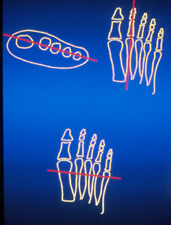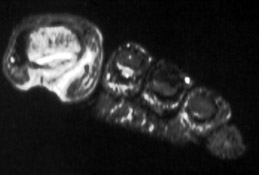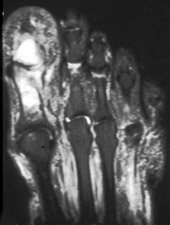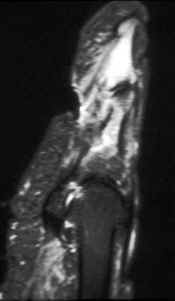Magnetic Resonance Imaging
MR imaging is the most sensitive and specific test for osteomyelitis. On MR imaging,
high signal intensity in the bone marrow on T2 weighted images is consistent with
osteomyelitis. Localized high signal intensity in the soft tissues on T2 weighted
images is consistent with soft tissue abscess. Low signal intensity in the bone
marrow on both T1 and T2 weighted images is consistent with neuropatic osteoarthropathy.
False positive exams can be seen with trauma and fractures, with osteonecrosis, and
occasionally with neuropathic joints.
MRI PROTOCOL
IMAGING THE FOOT
The diabetic foot should be imaged in three planes: axial, sagittal, and coronal.
Due to the confusion of labeling the cardinal planes in the foot, axial may be referred to
as long axis, and coronal may be referred to as short axis.
To optimize imaging, large fields of view should be avoided. The study should be
tailored to the individual needs of the patient. The foot should be visually examined with
bandages and wrappings removed. Since osteomyelitis occurs next to ulcers, these areas
should be clearly identified and imaged. Markers are placed over shallow ulcers that may
be difficult to appreciate on images.
The field of view is selected that covers the areas of concern. In general, the
forefoot and midfoot area are covered for evaluation of infected toes or ulcers of the
ball of the foot. The hindfoot, ankle, and midfoot are covered for ulcers involving the
calcaneus. Large fields of view should be avoided so that adequate detail and
visualization is obtained for even the smallest phalanges of the toes.
 |
The technologist obtains localizer images and plans the initial coronal
(short axis) sequences. |
 |
From this sequence, the axial (long axis) is planned by orienting the slice
grid along the axis of the metatarsals. |
 |
Sagittal sequences are then planned from the axial (long axis) plane. |
 |
Sagittal slices generally cover the entire width of the foot. Limited
sagittal coverage of the foot can be considered when evaluating for osteomyelitis of one
toe, which allows for thinner slices. |
In cases of alignment deformities, the technologist orients the slices to optimize
imaging of the area of concern. For example, in cases of hallux valgus, if the 1st toe is
evaluated for osteomyelitis, sagittal slices are oriented along the the 1st phalanges. If
the concern is more proximal, sagittal slices would be planned along the 1st metatarsal.
SEQUENCE CHOICES
T1 Anatomically detailed with high resolution. Sensitive for
bone marrow changes, however may miss bone marrow edema in the smaller phalanges.
T2 Less sensitive to bone marrow edema, especially when fast
spin echo sequences are employed due the bright signal of edema blending with the bright
signal of the fatty bone marrow. T2 with fat saturation avoids this problem, but the foot
may difficult to obtain a uniform fat saturation. Inhomogeneous fat saturation may lead to
diagnostic error.
STIR Very sensitive to bone marrow edema changes. Uniform fat saturation easily
obtained.
Intavenous gadolinium is generally not needed on a routine basis. It may
improve sensitivity for small abscesses or sinus tracts.
| Plane |
Sequence |
Time |
| Long axis(axial) |
T1 |
1:30 |
| STIR |
1:39 |
| Sagittal |
T1 |
1:30 |
| STIR |
2:06 |
| Short axis(coronal) |
STIR |
2:06 |
| Total time |
|
8:11 |
Table 4. MR Imaging of Osteomyelitis
| Reference |
Sensitivity |
Specificity |
| Yuh |
25/25 |
100% |
17/19 |
89% |
| Beltran |
6/6 |
100% |
5/7 |
71% |
| Wang |
45/46 |
98% |
13/16 |
81% |
| Newman |
2/7 |
29% |
17/19 |
67% |
| Nigro |
26/26 |
100% |
20/21 |
95% |
| Weinstein |
46/46 |
100% |
13/16 |
81% |
| Total |
150/156 |
96% |
85/98 |
87% |




